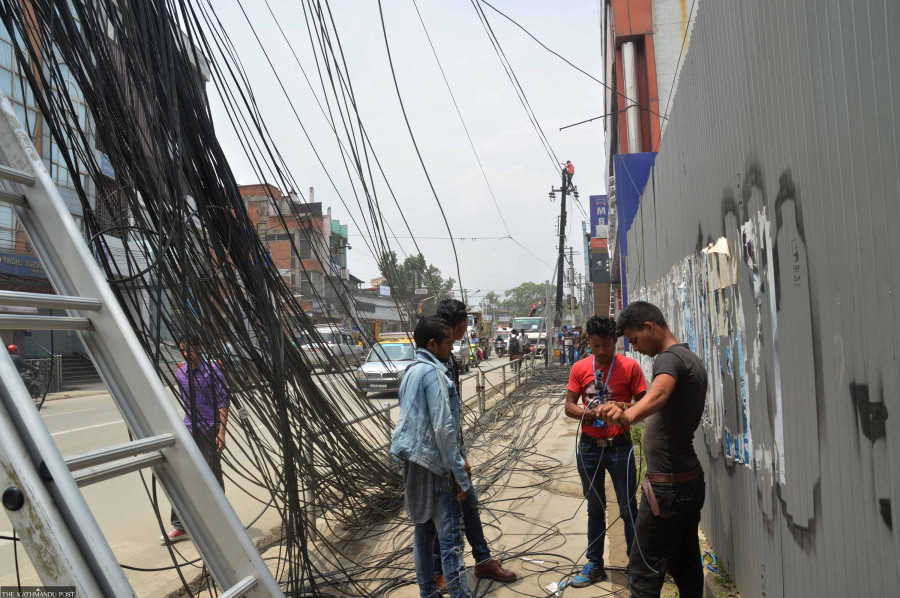Money
Valley’s power lines to go underground
Underground cables would cause smaller voltage drops and will reduce safety hazards caused by storms and lightning.
Krishana Prasain
Overhead low tension electric cables may be a thing of the past in Kathmandu Valley if the Nepal Electricity Authority’s plan to create an underground cable network is materialised.
The power utility on Friday announced that it would be removing electric poles from Kathmandu Valley and creating an underground cable network beginning next year as part of its efforts to modernise its decades-old ailing infrastructure.
Hanging cables and jumbled wires in Kathmandu's streets have been an eyesore.
Besides, according to the power utility, underground cables would cause smaller voltage drops and reduce chances of electricity theft. Such an underground cable network would also address safety hazards caused by storms and lightning strikes.
The undertaking would cost approximately Rs15 billion, the power utility said.
“We are all prepared to implement our underground cable plan in Kathmandu valley,” Kul Man Ghising, managing director of Nepal Electricity Authority, told an interaction on Friday .
He has urged other service providers to be prepared to use the optical fibre facility of the Nepal Electricity Authority under the infrastructure-sharing modality.
He was referring to cable TV operators, internet service providers and telecoms companies that have been using electricity authority’s poles for their cables.
As per the NEA’s plan, these service providers have to pay a fee for using its optical fibre facility.
“We are in the process of obtaining a permit to operate a separate infrastructure sharing company,” Ghising said.
He urged the other service providers not to make an issue after six months as the utility would remove all poles.
The power utility has installed underground optical fibres for internet service providers. “We need to coordinate with each other to use the infrastructure,” Ghising said.
Experts say that the underground electric cable network underground brings many advantages.
Such lines are protected from the wind and tree damage that are common causes of outages.
With underground cables, there is lower risk of electrocution.
According to reports, countries with underground power lines include Germany and the Netherlands. These countries do not experience the same risk of power outages and electricity-related injuries and death due to power line dangers that countries such as the US with above-ground power lines do.
Another state-owned entity, Nepal Telecommunications Authority, one of the key beneficiaries of NEA’s electricity poles, has supported the move.
Purushottam Khanal, chairman of the Nepal Telecommunications Authority, the telecom regulator, said as the power utility is removing the poles, it would require a separate operation modality to use the underground optical fibre on a common sharing basis.
“There is a need for a regulation for sharing of such infrastructure,” he said. “We hope the infrastructure sharing modality will begin from this project.”
The internet has reached 95 percent of the households.
According to Nepal Telecommunications Authority, electric poles are the key support system for internet cables.
There has been an unresolved electric pole dispute for the last four years between the Nepal Electricity Authority and internet service providers.
Commenting on the electricity pole fare dispute, Ghising said, “we will not be able to achieve the Digital Nepal target, set by the government, if we keep blaming each other.”
Nepal Electricity Authority, in September 2021, warned the internet service providers, telecoms companies and cable TV operators using the utility’s poles to string wires and clear up outstanding rent payments.
They were given several deadlines to settle the dues.
In October last year, the Nepal Electricity Authority had cut wires in nearly a dozen of places across the country, which led to disturbances in the internet connection over the pole rental fee issue.
Ghising said that they had increased the rate of using the infrastructure of the utility to modernize the system.
According to him, the new tariff has been fixed on a per kilometre basis.
“We are implementing a ‘last mile electrification’ project for the remaining 5 percent of rural electrification in the country, mostly covering Karnali and Sudurpaschim provinces,” he said. “The increased revenue will provide a big support for the expansion of the internet as well in this region.”
The country’s electrification rate has reached 95 percent, from 60 percent five years ago.
The last mile electrification project will be investing Rs100 billion.
Of the total fund, the Asian Infrastructure Investment Bank, China and European Investment Bank, Luxembourg will support Rs25 billion in a loan.
The last mile electrification project, according to Ghising, is the most expensive rural electrification project. To electrify one household, it would cost around Rs40 million under the project.
Ghising said that the power utility used to raise Rs400 million in revenue annually from the poles used by the internet and telecommunications service providers. After the tariff revision, it has increased to Rs700 million.
This is peanuts for the power utility whose annual revenue stands at Rs90 billion, Ghising said.
Baikunta Aryal, secretary at the Ministry of Communication and Information Technology, said there is a need for implementation of infrastructure-sharing modality.
“We have been trying to manage wire on electricity poles since 2009. But the problem still remains the same,” Aryal said. “A committee had submitted a report to resolve the pole issue but it has not been implemented.”
“I request the power utility to implement the report and internet service providers to self-declare and pay the revised rental fee for using the utility’s poles,” Aryal said. “I do not know why internet service providers do not pay the rental fee.”
Sudhir Parajuli, president of Internet Service Providers’ Association of Nepal, said that it has been four years since the pole rental fee dispute has remained unsolved.
“The power utility is fixing the rate for optical fibre,” said Parajuli. “As a monopoly, it can’t do that. It will be better that the rates are determined by the regulator.”




 5.4°C Kathmandu
5.4°C Kathmandu













%20(1).jpg&w=300&height=200)
